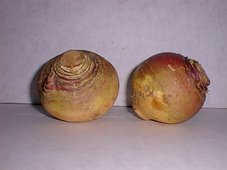 Few people realize that ARSI truckers log over 925,000 miles per year while delivering 2.73 million tons of rutabagas to various destinations around North America. That's why ARSI, along with several other large shippers, was chosen to take part in an extensive study of driver behavior by the Motorized Information-Sharing Technology Survey (MISTS) at the University of Southwestern North Dakota.
Few people realize that ARSI truckers log over 925,000 miles per year while delivering 2.73 million tons of rutabagas to various destinations around North America. That's why ARSI, along with several other large shippers, was chosen to take part in an extensive study of driver behavior by the Motorized Information-Sharing Technology Survey (MISTS) at the University of Southwestern North Dakota. The focus of MISTS was on the effects of familiar distractions reported by drivers everywhere, including the rampant use of modern technologies. The authors assumed that, "unfortunately, many drivers routinely allow themselves to be distracted from the road by hunger, boredom and the perceived need to constantly communicate with others." Reading, text-messaging, frequent laptop use, snacking and napping were by far the most common distractions reported by drivers.
Some of the results and recommendations of MISTS were surprising:
- Some highway snacks are safer than others. French fries and potato chips, though easily consumed while still watching the road ahead, were especially dangerous. Why? "They tend to be greasy, causing the fingers to slip off the steering wheel more readily," the authors note. Pizza posed relatively few risks, especially if the crust was thicker and therefore less likely to spill hot mozzerella onto the driver's lap.
- While there's no doubt that M&M's "melt in your mouth,not in your hand," this treat is less than ideal for snacking while driving. The reason? Drivers are likely to become distracted while groping on the seat or floor for dropped candies. Traditional chocolate bars may be safer.
- USA Today was the safest newspaper to read while driving, while The New York Times was the most dangerous. The reason? USA Today has short articles, with shorter words, and the articles all appear on the same page. Turning newspaper pages while driving was particularly hazardous. And Readers Digest is far safer than the novels of Proust or Joyce.
- Text-messaging and email drafting should be limited to straight stretches of the highway, with no more than five words entered at any one time. Be sure to allow a few extra seconds between yourself and the car ahead of you. Use abbreviations or acronyms where possible and do not feel that you need to respond instantly to incoming messages.
- In another surprising finding, many drivers could nap without incident on long straightaways during periods of light traffic, provided they set an alarm to limit snoozing to no more than 30 seconds. Napping drivers should never set their cruise control at speeds higher than the limit.
- If you're going to watch a YouTube video that's longer than 30 seconds, be sure to slow to within 10 mph of the speed limit.
The authors of the MISTS study conclude: "While we don't want to encourage dangerous driving behaviors, we simply must recognize that many drivers will seek out distractions from the tedious chore of driving. Our goal is therefore to identify and stigmatize the most dangerous behaviors in the hope of encouraging safer driving habits."
PHOTO: ARSI delivery truck loaded and ready to roll (unmarked to discourage road piracy).





